

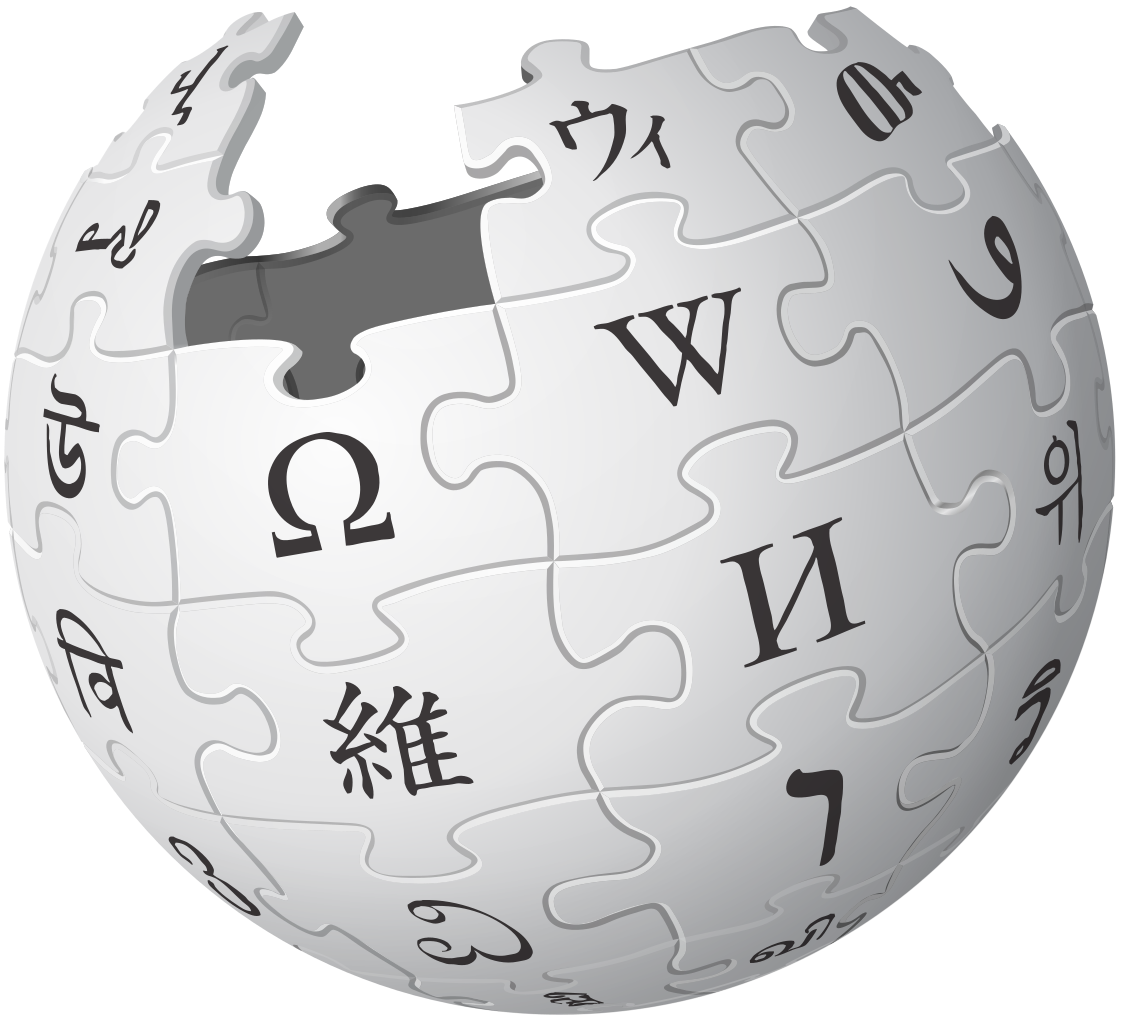 Wikipedia Sitemap |
|
|  Useful Links 1 Useful Links 2 |
While we were waiting to jump the railway cars, which would be the same time that the allies attacked the city, we got word that everything was cancelled. The total surrender of the troops occupying Holland was signed in the city of Wageningen. Here in Amersfoort, the local commander of "DER DEUTZEN WHERMACHT", handed the reign over to the captain - our captain of the resistance, even before the Canadians entered the city.
It sure was a strange sight to see the boys of the Underground with their blue coveralls, rifles on their shoulders, guarding HOTEL DE WITTE, where the surrender took place. Not a single German was visible on the streets. It seemed like a lull before the storm. And indeed the storm did come soon.
On a beautiful spring day in the beginning of May 1945, the Canadian army came rolling into Amersfoort. Five years of oppression, murder, injustice, hate and hunger had come to an end.
At the sound of the first motorized columns of liberators, the people came streaming out of their houses, basements and hiding places to welcome the so long awaited armies, who fought so hard to give us back our precious freedom lost so long ago.
Spring flowers, hugs and kisses could not nearly express the feeling that was in the heart of the living. And with the liberators, came food - the most valued commodity on earth at this time for the hungry. The first thing we got was a tin called SPAM containing wieners. It tasted like angel food. What did angel food taste like? We didn't know or care - all we knew was it was unbelievably tasty, right out of the tin.
Related resources:
As an active member of the Dutch Onderground, Carl Kaas was able to obtain Exemptions from the Officials so he could move around without restrictions to do his job in the Resistance Movement against the Germans occupying the Netherlands during World War II.
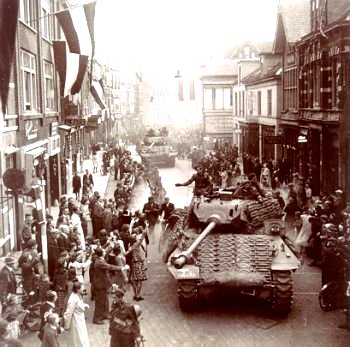 17 April 1945 Canadian lead tanks roll into Apeldoorn Photo from bouwman.com |
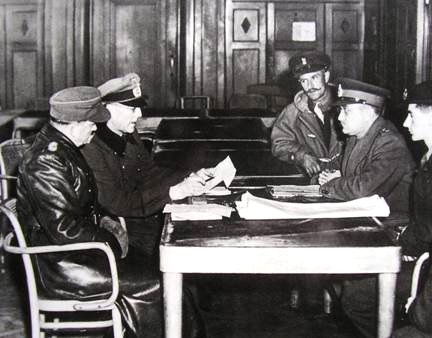 5 May 1945 Hotel 'De Wereld' in Wageningen, Netherlands Photo from wageningen1940-1945.nl |
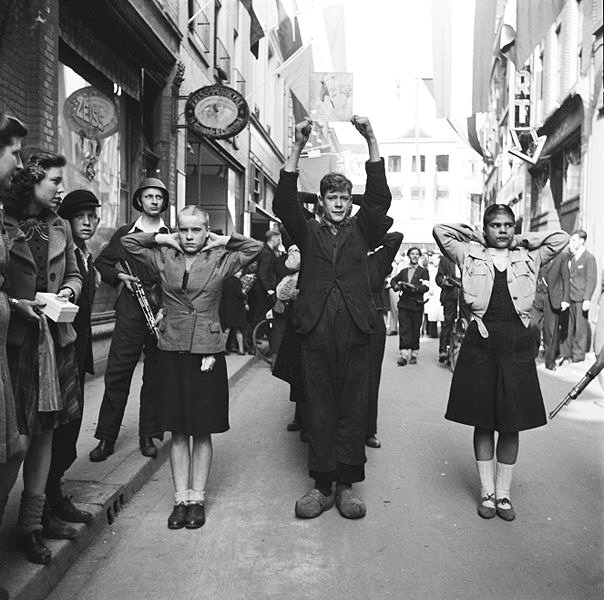 Member of the NSB and moffenmeiden being rounded up Photo from en.wikipedia.org |
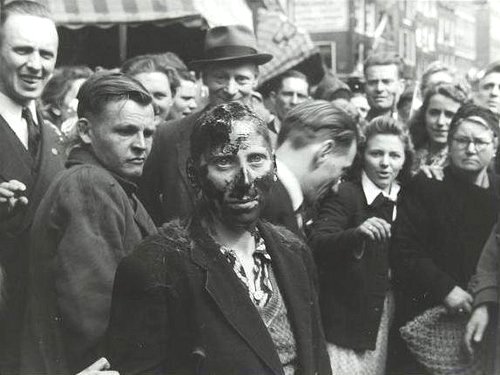 Moffenmeiden shamed after Liberation 1945 Photo from farm5.static.flickr.com |
Amersfoort concentration camp from Wikipedia. "Amersfoort was a transit camp, where prisoners were sent to places like Buchenwald, Mauthausen and Neuengamme. It was on July 15, 1942 that the Germans began deporting Dutch Jews from Amersfoort, Vught and Westerbork to concentration camps and death camps such as Auschwitz, Sobibor and Theresienstadt ... The facility remained in operation under the auspices of the [Dutch] Red Cross until May 7, [1945] when Canadian soldiers of the First Canadian Army arrived to officially liberate the camp. Soldiers of I Canadian Corps fighting north from Arnhem were halted about a mile from Amersfoort before the end of the war, and liberation came on the day the German forces laid down their arms in the Netherlands."
Dutch Helper List. WW II Netherlands Escape Lines. Researching the aid given to downed Allied airmen by the Resistance during World War II in The Netherlands, Belgium, and France.
The German capitulation - Hotel de Wereld. History of the National Committee Commemoration Capitulations 1945 Wageningen (NCHC). On May 5th, 1945 in the Hotel 'De Wereld' in Wageningen the surrender terms of the German forces in the Netherlands were negotiated. On the German side there were among others General Blazkowitz and on the Allied side there was Lieutenant-General C. Foulkes of the 1st Canadian Army, all in the presence of his royal highness Prince Bernhard. On May 6th, 1945 in the auditorium of the Agricultural College (next to Hotel "De Wereld") the capitulation was signed. The occupation of the Netherlands had come to an end.
Liberation from Wikipedia. "After crossing the Rhine at Wesel and Rees, Canadian forces entered the Netherlands from the east, liberating the eastern and northern provinces. The western provinces, where the situation was worst, however, had to wait until the surrender of German forces in the Netherlands was negotiated on the eve of May 5, 1945 (three days before the general capitulation of Germany), in the Hotel de Wereld in Wageningen."
The Liberation of the Netherlands. "On 17 April, 1945, the Canadian lead tanks roll into Apeldoorn, loudly cheered by relieved residents. The alt="Moffenmeid Kaal geknipt Google image from https://images4.persgroep.net/rcs/De71iMOxDGjytcCnHubnh17absI/diocontent/70274006/_crop/0/0/693/789/_fitwidth/581?appId=e9b4e2a1869038ffcaf318a6d1463b0b">Liberation of the Netherlands was completed on May 5, 1945 by the First Canadian Army.
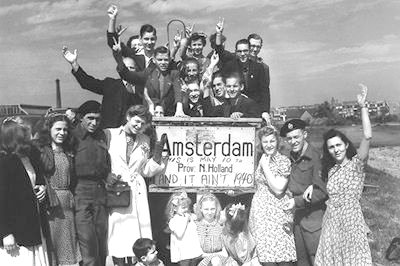
The Liberation of the Netherlands from the Canadian Encyclopedia. "In the final months of the Second World War, Canadian forces were given the important and deadly task of liberating the Netherlands from Nazi occupation."
Moffenmeid from Wikipedia, Netherlands. Info from Dutch Wikipedia loosely translated: "Dutch women and girls who had a love relationship with German soldiers or officers of the Wehrmacht, Waffen-SS, or Kriegsmarine during the occupation of the Netherlands in WWII were derogatorily called 'moffenmeid' or 'moffenhoer' (Krautgirl or Krautwhore), and were treated harshly. The Dutch word "mof" (meaning "sleeve") is a slur negatively referring to Germans, like Kraut in English. The women in question were sometimes pro-German or prostitutes, but often it was only women who had German husbands or mates.
When the war ended, these women were dragged through the streets and publicly shamed by an 'Orange mob' of anti-German Dutch people, celebrating their liberation from the brutal Nazi occupation. The Moffenmeiden's dresses were ripped and torn, and their heads shaven bald and smeared with pine-pitch. They were also beaten and sworn at. Some of them were put in a chair on a stage with their heads shaven bald for all to laugh at.
It is not known exactly how many women had a relationship with a German during the occupation. It is estimated that there were about 140,000. During the occupation, there was a very negative picture of these women. Many Dutch people believed that these women were Nazi sympathizers and benefited from their association with German soldiers.
From such relationships, 13,000 to 15,000 children were born. From the summer of 1942, women who were expecting a child by a German soldier could obtain support and assistance from the National Socialist Volkswohlfahrt (NSV), which operated special obstetrics clinics in Amsterdam and Rotterdam. Marriages between Dutch women and German soldiers also occurred. Minor Dutch girls could marry German soldiers during the occupation without the consent of their parents. From mid 1942 to mid 1943, 1600 German soldiers requested permission from the Dutch army to marry Dutch girls or women."
'Moffenmeiden' have their heads shaved. "After the liberation, the Dutch people vent their anger on the 'moffenmeiden' - women and girls who had had any kind of friendly contact with German soldiers. They have their hair cut off in public and their heads shaved. Often a swastika is painted on their heads and they are driven around in an open wagon. By allowing this 'controlled revenge', the Netherlands Military Administration hopes to avoid a 'Day of Reckoning', a free-for-all in which reprisals against collaborators take place without restraint."
The National Socialist Movement in the Netherlands. (Dutch: Nationaal-Socialistische Beweging in Nederland, NSB) was a Dutch fascist and later national socialist political party. "After the German signing of surrender on May 6, 1945, the NSB was outlawed. Mussert was arrested the following day. Many of the members of the NSB were arrested, but only a few were convicted. Mussert was executed on May 7, 1946."